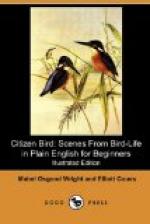“Of course—I don’t see why I said that, for I know Woodpeckers only hammer and croak,” said Rap.
“The family of Mockers, Thrashers, and Wrens is one of the most interesting that we shall meet in our Birdland excursions, for all its members are bright intelligent birds and great talkers. They have something to say for themselves and say it so cleverly that we do not care if their feathers are of sober grays and browns. This family should be very proud of itself, but it does not show any false pride or exclusiveness; its different members are as sociable and friendly as possible, building their nests in bushes not far from the ground, and taking every occasion to chat confidentially with House People. Some of these friendly birds are the Sage Thrasher, the Mockingbird, the Catbird, the Brown Thrasher, the Rock Wren, the House Wren, and the Long-billed Marsh Wren, the last being the only really shy bird among the seven I am going to tell you about.”
[Illustration: Sage Thrasher.]
“Do Wrens and Mockingbirds belong to the same family?” asked Nat. “One so little and one so big! Mother had a Mockingbird in a cage once, but it got out and flew away to live in the park, she thought.”
“They are cousins and belong to the same large family, though to different households, like House People.
“The Sage Thrasher belongs only to the West, just as its relative the Brown Thrasher belongs to the eastern part of the country. When your Cousin Olive and I lived one summer here and there, from Colorado westward, it was this bird that made us feel at home by its sweet sociable music.
“Everywhere in that mountainous region the sagebrush, with its blue flower spikes, spreads over the ground, making a silvery greenness where other plants could not grow. In and out of the sage, nests and scratches and hops this Thrasher, taking its name from the plant. He also ventures up on the mountain sides, giving his inquisitive, questioning, mocking notes, and so earns a second name in those places, where he is called the Mountain Mockingbird.
“Though he is a good deal smaller than the true Mockingbird of the South, they have many points in common. They can both imitate almost any sound that strikes their fancy, such as the songs of other birds, whistle various tunes of their own, and almost mock the peculiarities of human speech. Not that they all do it—oh, no, many have only their own beautiful natural song; every Mockingbird has not the power of imitation, but certain members of the tribe acquire a knack of mockery of which they seem quite conscious.
“The Sage Thrasher, though gentle and sociable in its wild state, does not thrive in cages as well as the true Mocker. It seems to miss the broad expanse of plain and mountain to which it has been used, and seldom lives long in confinement.
“Read what you have written about the size and color of this Thrasher,” said the Doctor to Rap.




